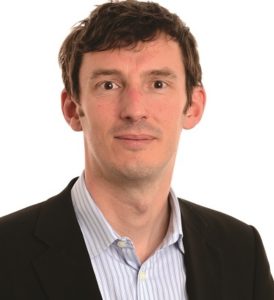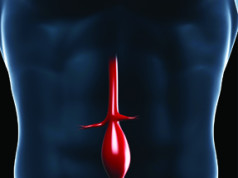
What do Formula 1 cars, space shuttles and airplanes have in common with a ruptured aneurysm? In this article, Colin Bicknell writes about the importance of a well-oiled response strategy for endovascular aneurysm repair (EVAR) of a ruptured aortic aneurysm.
On 31 July 1994, during the German Grand Prix, Jos Verstappen’s pit stop refuelling resulted in the spontaneous ignition of litres of fuel, after the high-pressure hose failed to engage with his Benetton F1 racing car. The pit stop team and driver were ablaze. The fire was extinguished four seconds later. The driver at the centre of the furnace suffered minor burns to the face only.
Four seconds only to extinguish the fire. It is clear that this was a professional, well-rehearsed team, where the end results of meticulous, planned training are evident in this crisis scenario. The question is, can we get to be as good as this in vascular and endovascular teams dealing with ruptured aneurysms? If we are to, then there are certain principles that we need to pay attention to in training and rehearsal.
Vitally important is a need to pay attention to the whole pathway and every aspect of that pathway. Many years ago, after the Challenger space shuttle crash, Diane Vaughan examined the reasons the disaster occurred in her popularised book. The book explores far beyond the technical failure of the O-ring. Her in-depth analysis moved beyond the technical failure and beyond individual actors to explore the organisational and environmental context in which the launch decision was made. She concluded that there were aspects of the working patterns of NASA that led to a “normalisation of deviance” and a belief that the risk of failure of the O-ring was acceptable. This environment, with many teams working together to achieve something highly complex and technical, has some real parallels with EVAR for ruptured aneurysms, and we can learn from this examination of the system.
The culture and the way we work in the NHS and elsewhere in international healthcare is very variable, depending on many factors. As part of a large multicentre study, researchers at Imperial examined the culture at 10 different vascular units with 275 multidisciplinary theatre team members in each. The scores for team work overall were on the borderline of acceptability, but proportion of respondents with positive perceptions is very low in some units and there is significant variation. As a vascular community, we have not matched our desire to centralise vascular units with our desire to pay attention to training the whole team.
It is intuitive that there is a need to focus on reducing error, but the focus needs to be well directed. The LEAP study1 was a National multi-centre study of 185 cases of aortic surgery that examined the landscape of error modes in the vascular theatre. In total, 856 errors were recorded, a median of four errors per procedure (1.2 errors per hour). There was a wide spread of errors in different categories, but errors around equipment used, errors independent of the procedure and communication and team-working errors featured strongly compared to technical errors, where we traditionally place most emphasis on training. Fourteen errors directly contributed to patient harm, half of these occurred because of team related failures. In addition, patients with an increased number of major errors were more likely to need reoperation, postoperative complications and death. This study demonstrated patterns of error that informed us that we need to pay attention to the equipment, communication and system the procedure takes place in, equally as much as the technical aspects of EVAR.
If we are to improve, we do have to question where we start. Again, we can turn to sport and training for some guidance. The British cycling team is world beating. Much of their success is attributed to a focus on detail—which one would also expect in the operating theatre. The principles of marginal gains has been popularised by Dave Brailsford, UK cycling performance director. He has said, “The principle comes from the idea that if you break down everything you can think of that goes into riding a bike, and then improve it by 1%, you will get a significant increase when you put them all together.” This principle should be used in training teams.
If the above solves what we rehearse then the next question is how we rehearse. It was described over 100 years ago by Robert Yerkes and John Dodson that performance increases with physiological or mental arousal or stress, but only up to an inflexion point, after which, when the stress is too high, performance decreases. This should mean that it is commonplace for teams to train together in a stressful environment, both to enhance their performance in training to see what can be achieved and to rehearse effectively to reduce the time where there is an overload of stress in the when dealing with the rupture and maintain an optimum level of performance. Of course, this is not commonplace. It is, however, possible to train in using immersive simulation either in purpose built simulated angiography suites or using simulator integrated into the hybrid lab.
Lastly, we need to move further than just relying on safety checks that have the potential to cause a degree of misplaced trust in team preparedness. Checklists have their place but are not infallible. On 25 March 2019, the newspapers reported that a British Airways plane bound for Germany landed in Scotland, despite all checks being made without question. We all see the same in the vascular theatre.
To summarise, If we are to get ruptured EVAR to the next level we need to train to include the entire pathway of care and every aspect, work on our culture of team-working, focus on error reduction in the right way and train as teams in high-pressure environment.
At Imperial, we propose given this evidence that proactive team training should be a mandatory part of training, and of effective institutional governance. Training should be as a team utilising an immersive simulated angiography suite or in situ in an empty theatre (perhaps every time a case is cancelled) where we can monitor, feedback and rehearse situations and now, even patient specific cases.
For rupture situations the simulated immersive environment appears valid according to studies examining fully simulated cases. Experts complete each step of the procedure faster and with greater proficiency and the subjective views of experts demonstrate the realistic nature of the simulator. In this highly controlled environment, a definite advantage of training can be seen if a structured debriefing focusing on technical and non-technical skills is integrated into a training programme. Retesting after this shows significant improvements in communication, coordination, co-operation, leadership and team monitoring.
The programme should include, but not be limited to, a weekly multidisciplinary team training schedule that involves all team members from the ward and theatres, involving surgeons, anaesthetists, radiologists, radiographers and nursing staff. The programme should be structured, tackling routine and emergency scenarios and should be able to react to serious incidents that occur in real cases. Teams should be able to safely, practice and introduce new pathways of care using this model. At Imperial, this is what we aspire to.
Can the rupture situation be as smooth and as prepared as the F1 pit stop? The experience of the major teams in F1 is that getting the pit stop crew to be the best in world is highly complex. It involves interviewing and selecting crew to be a tyre changer, and for each and every role, training them all like athletes, studying their gaze patterns to ensure lightening fast reactions and getting the cars to stop within millimetre accuracy.
Think of the ruptured aneurysm patient coming in, always to the same bed in the same position, treated by the specialist phlebotomist that takes the cross match selected for this role after a series of interviews, before the trained athlete runs the blood to the lab, alongside the other twenty members all selected to do their specific jobs and trained 365 days a year. Of course this is impractical, but there is much we can achieve if we focus on teams, their culture and the whole pathway, and train for crisis in an immersive real-life environment, focusing on reducing error.
Colin Bicknell is a senior lecturer and consultant vascular surgeon at Imperial College London, UK.
References
1. Lear R, Riga C, Godfrey AD, et al. Multicentre observational study of surgical system failures in aortic procedures and their effect on patient outcomes. Br J Surg. 2016 Oct;103(11):1467–75.












